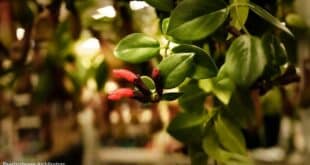Meet The Hoya Heart Plant (Hoya Kerrii) If any plant truly captures the heart, it’s the Hoya Kerrii. Affectionately known as the “Sweetheart Hoya” or “Hoya Heart Plant,” its perfectly heart-shaped, succulent leaves make it one of the most recognizable and beloved Hoyas in the world. Often sold as a …
Read More »Creating the Best Hoya Plant Soil Mix for Long-Lasting Beauty
Understanding the Right Soil Mix If you’ve ever admired the waxy, elegant leaves and delicate blooms of a Hoya plant, you know they’re a special addition to any home. But for many plant lovers, the journey to a happy Hoya can be filled with a few stumbles. One of the …
Read More »How To Get a Hoya Plant To Bloom? 7 Secrets to Unlock Those Famous Flowers
Understanding Why Your Hoya Isn’t Blooming Are you staring at a beautiful, leafy Hoya vine that grows and grows, yet stubbornly refuses to produce its iconic, star-shaped flowers? It’s a common frustration that brings many plant owners to ask the same question: how to get a hoya plant to bloom? …
Read More »Hoya Rope Plant: Everything You Need to Know About ‘Krinkle Kurl’
Meet The Hoya Rope Plant ‘Krinkle Kurl’ If you’re looking for a houseplant that doubles as a piece of living sculpture, look no further than the Hoya Rope Plant. With its tightly curled leaves that cascade in thick, rope-like chains, this plant is an unforgettable addition to any collection. Known …
Read More »The Art of Boston Fern Care: Humidity, Light, and Love
A Good Choice: Boston Fern (Sword Fern) Hello there! Are you thinking about bringing a Boston Fern into your home? That’s a fantastic idea! They are a true classic for a reason. With their lush, feathery fronds and a natural, graceful arching shape, they can make any space feel a …
Read More »How Often to Water a ZZ Plant: Expert Tips
Why Watering Matters Most for ZZ Plants How often to water a ZZ plant is the most important question every ZZ plant owner should ask to ensure their plant stays healthy and thrives indoors. The Zamioculcas zamiifolia, or ZZ plant, has earned its reputation as one of the toughest, most …
Read More »Goldfish Plant Care: The Ultimate Guide to Happy, Blooming Plants
Meet The Goldfish Plant If you’re searching for a unique and rewarding houseplant, look no further than the Goldfish Plant. With its playful, fish-shaped flowers and lush, trailing foliage, this plant is sure to become a star in your indoor garden. Whether you’re an experienced plant enthusiast or a beginner, …
Read More »Masculine and Memorable: Best Father’s Day Flowers in 2025
As Father’s Day approaches, the question “What gift should I get this time?” starts circling in our minds. When we think of flowers, mothers usually come to mind, but actually men also respond very positively to well-chosen flowers! As both a wife and daughter, I’ve observed that while men approach …
Read More »Lipstick Plant Care: How to Keep Your Plant Looking Its Best
Meet The Lipstick Plant In my previous article, I gave you general information about Lipstick Plant, this time I will tell you about lipstick plant care tips. The Lipstick Plant, known in the literature as Aeschynanthus radicans, is one of my favorite plants. With its dark, tube-like calyces and vibrant, …
Read More »Hoya Plant Care in Summer vs Winter: What Changes?
Let’s Meet Hoya Plant Hello Hoya Plant lovers!In this post, I’ll be sharing both expert tips and my own personal experiences when it comes to Hoya plant care. By the end of this article, I truly hope I’ll have answered all the questions you might have about caring for these …
Read More »









